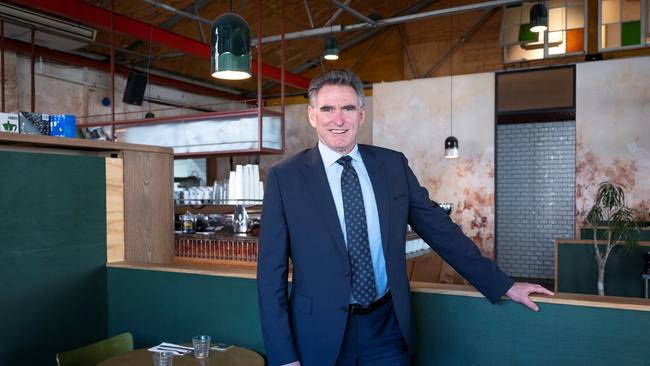NAB lifts third-quarter cash earnings to $1.8bn, signals higher costs
The bank’s earnings update left investors jittery about revenue growth in the final months of its financial year, amid softer-than-expected income and a larger rise in annual costs.
Business
Don't miss out on the headlines from Business. Followed categories will be added to My News.
National Australia Bank’s June-quarter earnings update left investors jittery about revenue growth in the final months of its financial year, as several analysts noted softer-than-expected income and a larger rise in annual costs.
While NAB’s chief executive Ross McEwan declared the bank in “good shape”, the trading update underwhelmed analysts who had been expecting greater underlying business momentum and more of a benefit from rate hikes in May and June.
NAB said unaudited cash earnings were $1.8bn in the three months ended June 30, up from $1.7bn in the same quarter last year. The bank’s net interest margin – what it earns on loans less funding and other costs – was “slightly lower” over the quarter, compared to March 31.
Excluding NAB’s markets and treasury unit which posted lower income in the quarter, the bank said its net interest margin was “up slightly”, helped by the benefit of a rising interest rate environment.
NAB rules off its financial year on September 30 and investors and analysts are hoping it has a strong finish.
But NAB said June quarter expenses rose 1 per cent – excluding the $1.2bn acquisition of Citigroup’s retail banking unit – primarily due to increased staff costs. The bank also ratcheted up its full-year cost growth expectations to 3 per cent to 4 per cent, after earlier signalling in May costs were estimated to be up 2 per cent to 3 per cent.
NAB’s shares dropped 2.9 per cent to $29.81 on Tuesday, marking the stock’s biggest one-day fall in almost two months.
“Guidance for FY22 cost growth is now 3-4 per cent, suggesting small downside risk to consensus expectations,” Jarden’s Carlos Cacho said.
“Overall, a weaker underlying result despite a modest headline beat. While underlying NIM (net interest margin) was ‘up slightly’, we find the lack of detail and deterioration in headline NIM disappointing, especially considering the better result (and detail) from ANZ’s Q3 trading update.”
JPMorgan analyst Andrew Triggs said while NAB’s fourth quarter would be helped by further rate hikes in June and July, the bank’s performance would need to accelerate to achieve his profit expectations.
“NAB’s 3Q22 trading update was slightly softer than our expectation, with cash NPAT of $1.8bn for 3Q22 running behind our forecast of $3.76bn for 2H22 and some work to do on underlying revenue in Q4 to hit our numbers,” he added.
The bank’s higher cost guidance was linked to a “top-up to payroll and customer-related remediation provisions” of $60m to $100m. In 2020, NAB identified under and over payment issues in its payroll for staff and has been working through the financial impact of that.
The bank’s cost assumptions also include expenses of $80m to $100m associated with complying with an enforceable undertaking with financial crimes regulator Austrac.
When compared to the average of NAB’s first two quarters, the June-quarter cash earnings printed 3 per cent higher. But expenses rose 1 per cent – excluding the acquisition of Citigroup’s retail banking unit – primarily due to increased staff costs, through the quarter.
Despite official rate hikes, the bank reported improved credit quality with the ratio of loans 90-days past due in repayments falling 5 basis points to 0.7 per cent.
“Our performance this quarter is pleasing, highlighting the ongoing execution of our strategy including completing the acquisition of Citigroup’s Australian consumer business,” Mr McEwan said. “As the economy changes, continued low unemployment and healthy household and business balance sheets are helping mitigate the impacts of higher inflation and higher interest rates.
“The majority of our customers are well placed to manage these challenges, including approximately 70 per cent of customer home loan repayments ahead of schedule … Our business is also in good shape for this evolving environment.”

NAB’s credit impairment charge printed at $11m, and compared with March 31 the ratio of collective provisions to credit risk-weighted assets dipped by 1 basis point to 1.30 per cent.
Revenue rose 2 per cent in the June quarter, excluding the Citigroup retail purchase. Including the acquisition, revenue climbed 3 per cent. Expenses were 3 per cent higher, including the Citigroup retail purchase.
The bank’s common equity tier one ratio was 11.6 per cent as at June 30, compared with 12.5 per cent three months earlier. The latest capital ratio includes a reduction from payment of the 2022 interim dividend and impact from shares acquired under the ongoing on-market buy back. The acquisition of Citigroup’s local retail banking unit subtracted 31 basis points.
NAB said its estimated proforma common equity tier one ratio was 11.3 per cent, which includes a reduction from the $1.7bn in the shares that are still to be purchased under the buyback and proceeds from selling its BNZ life insurance arm.
“Balance sheet settings remain strong and we are well advanced on our FY22 term wholesale funding task with $34bn raised by end June,” Mr McEwan said. “Investments to deliver simpler, more digital experiences for customers and colleagues are supporting balanced growth and productivity benefits which are expected to exceed $400m in FY22.
“We will continue to focus on getting the basics right, managing our bank safely and improving customer and colleague outcomes to deliver sustainable growth and improved shareholder returns.”
Commonwealth Bank, which reports full-year earnings on Wednesday, has outlined several one-off items that will impact its second-half result.
CBA will deliver a cash profit of about $9.4bn for the year ended June 30, according to Bloomberg’s analyst estimates.
In May, NAB reported an increase in interim cash profit to $3.48bn and lifted its dividend.
More Coverage
Originally published as NAB lifts third-quarter cash earnings to $1.8bn, signals higher costs





